How to Draw a Pint of Beer TUTORIAL

Brewmaster Garrett Oliver pairs favorite beers with works from the Museum's collection.
Garrett Oliver
October two, 2019
In fourth dimension for Oktoberfest, we asked Garrett Oliver, brewmaster for the Brooklyn Brewery and editor of The Oxford Companion to Beer, to take a stroll through the Museum's drove and brand some pairings. Sláinte!
When you brand beer for a living, people have questions. And the question I'grand most frequently asked is not a technical question, but this: "How does an African American guy from Queens, New York, with a degree in film end upwardly beingness a brewmaster? Where is the connection?" The respond to the commencement part of the question is long and circuitous and will accept to wait for another day.
Merely the second part is easy: mentally and spiritually, making beer is exactly like filmmaking and other art forms. You start with history, forms, and predecessors so you apply to them both art and scientific discipline, hopefully in roughly equal measure out. In order to make something worthwhile, either equally a brewer or an artist, you have to have something to say, but also the technical ability to say it.
So let's take a stroll through MoMA's vast collection, beers in hand, and find some connections. Beer, like art, is deep and broad and tall. We're going to end up in unexpected places.
Irish gaelic STOUT

Sean Scully. Big Grayness Robe. 2002
Possibly no country is so closely associated with a single beer every bit Ireland is with Guinness. Irish literature is stacked high with praise and love for Irish stout, and Guinness is often mentioned by name. Stouts are warm-fermented beers that gain their flavors and color largely from heavily roasted malts. These give rise to flavors reminiscent of nighttime chocolate and coffee.
MoMA's collection holds many smashing images of Ireland, but I was drawn to Dublin-born Sean Scully's Big Gray Robe (2002). When I await at this piece, I seem to "feel" a pint of Guinness. The colors—tan, black, chocolate, gray. Guinness, when poured, at first appears almost cream-colored, simply as the bubbles wend their fashion upwardly the glass in their patented waves, the appearance is transformed. Does this painting in fact depict the many aspects and moods of "a pint of plain," equally Guinness was once called?
SAISON

Gertrude Käsebier. The Road to Rome. 1902
Straddling the borders between Belgium and France, Wallonia is best known for the farmhouse beer style known as "saison." Once, every farm had its own beer, and eventually the farms started to trade their beer with each other and the full general public. Past the early 20th century, the saison become somewhat standardized every bit a strong-ish, hazy beer with a circuitous peppery flavor and the volcanic texture of flossy bubbles that merely canteen refermentation (similar to the method used to make Champagne) tin can achieve. Our beer hither is the most first-class Boulevard Tank 7 Saison, a classical American-brewed instance.
I've paired it with Gertrude Käsebier's The Route to Rome (1902). The scene is pastoral; in that location must exist a farm nearby, but it can no longer be seen. The road winds on and all should seem beautiful…then why do we feel menaced? Is the child in the foreground playing, or lost? Saison may take lost its style too. Of a sudden there are all sorts of saisons—sour types, barnyardy throwbacks featuring funky wild yeasts—and then who can be sure what a saison is anymore?
AMERICAN "FRUIT SOURS"
Beach Coating Bingo. 1965. The states. Directed by William Asher
Sometimes beer is but supposed to be fun. Equally the American food world descended into The Matrix of mid-20th-century nutrient civilization, nosotros turned our food into facsimiles. Bread became a dead chemical sponge and cheese became plastic (literally, and frequently packaged between two other pieces of plastic). Among the things nosotros erased was an unabridged genre of beers based on lactic acidity rather than hop bitterness. And equally our food culture comes roaring back to life, "sour" beers have started to make a comeback. But rather than brewing them to be every bit sharp as the term "sour beer" may sound, many brewers are making fun versions full of actual fruit.
One of my favorites is Funkwerks Raspberry Provincial from Fort Collins, CO. It has a gentle tang, a mere wisp of spicy funkiness, and and so splashes into the raspberry pool. And then, from MoMA's pic drove, I chose Beach Blanket Bingo (1965), the "mmmmm....I don't care what anyone says...it has fruit" of movies: don't overthink information technology—just sentry information technology and smile.
Brownish ALE
A Send Is Born. 1942. USA. Directed by Jean Negulesco
Brownish ale was once the beverage of British workers, none more than the once-iconic Newcastle Brown Ale. Night with roasted and caramelized malts, brown ale was once said to be full of free energy—"a meal in a glass." These beers bring to mind all sorts of laborers—blacksmiths, field hands, coal miners—but peculiarly shipbuilders. In Uk's shipbuilding yards, the workers worked hard and saw little glory or wealth. As Thatcherism gained a steely grip in the Great britain of the 1980s, the British working course was slowly chipped away. Brownish ale was chipped away with information technology.
Diving again into MoMA's film collection, we bring you lot A Ship Is Born (1942), a propaganda motion-picture show near the last golden age of ships that subdued continents and won wars. People still drink Newcastle Brown Ale, and it'south a nice beer. Simply the shipyards are largely silent now, and those that are left are building oil tankers, container ships, and cruise vessels to convey to us our material dreams.
Aboriginal beers were invented in Africa and belong to all the peoples of the World, not simply to Europe.
INDIA PALE ALE (IPA)
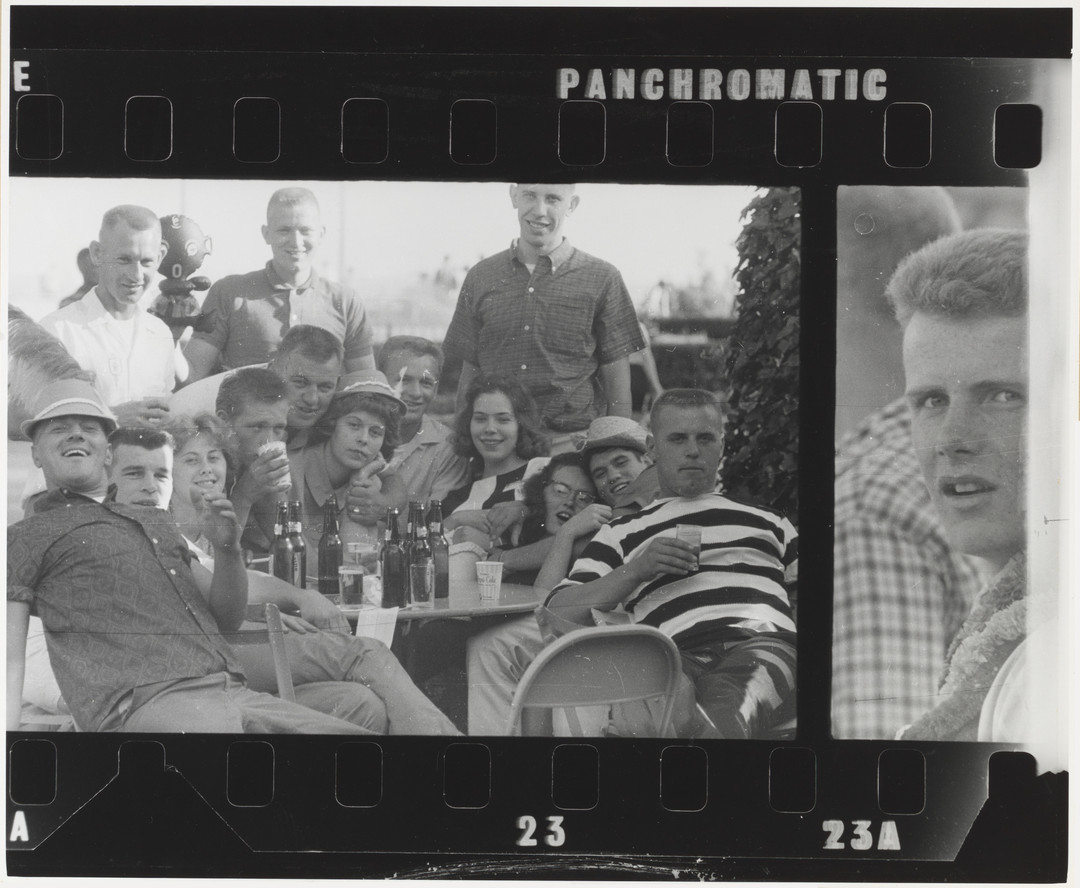
Michael Ciavolino. *Boat Ride, Rye Beach.*1962
The electric current winner of the modern beer world is surely the Bharat Stake Ale, better known as the IPA. As the proper name suggests, it was an outgrowth of British colonialism in India. In the 18th and 19th centuries, the British shipped the beer from England and Scotland, one-half-way 'circular the world, to supply the colonists. The beer that survived the voyage best was strong and bitter. Modern brewers have taken the flavors of IPA—big, bold, and florid with hops—and turned the style into the flagship of the movement confronting flavorless industrial beers. The result can involve a certain homogeneity. Shall we call it "bro-ism"?
My photograph is Michael Ciavolino'due south Gunkhole Ride, Rye Beach (1962). What practise you come across? Does it look like fun? Do they wait friendly? They're certainly laughing. Are they laughing with y'all...or at yous? What looks like people having a good time is somehow tinged with a toxic male energy. Some of us who are familiar with the geeky-cliquey beer scene can chronicle. Our beer is Tree House Brewing's Julius. It's really skilful and super-pop. But is it fair to pin all this on Julius? No, it's not fair. Neither is life.
DOUBLE IPA
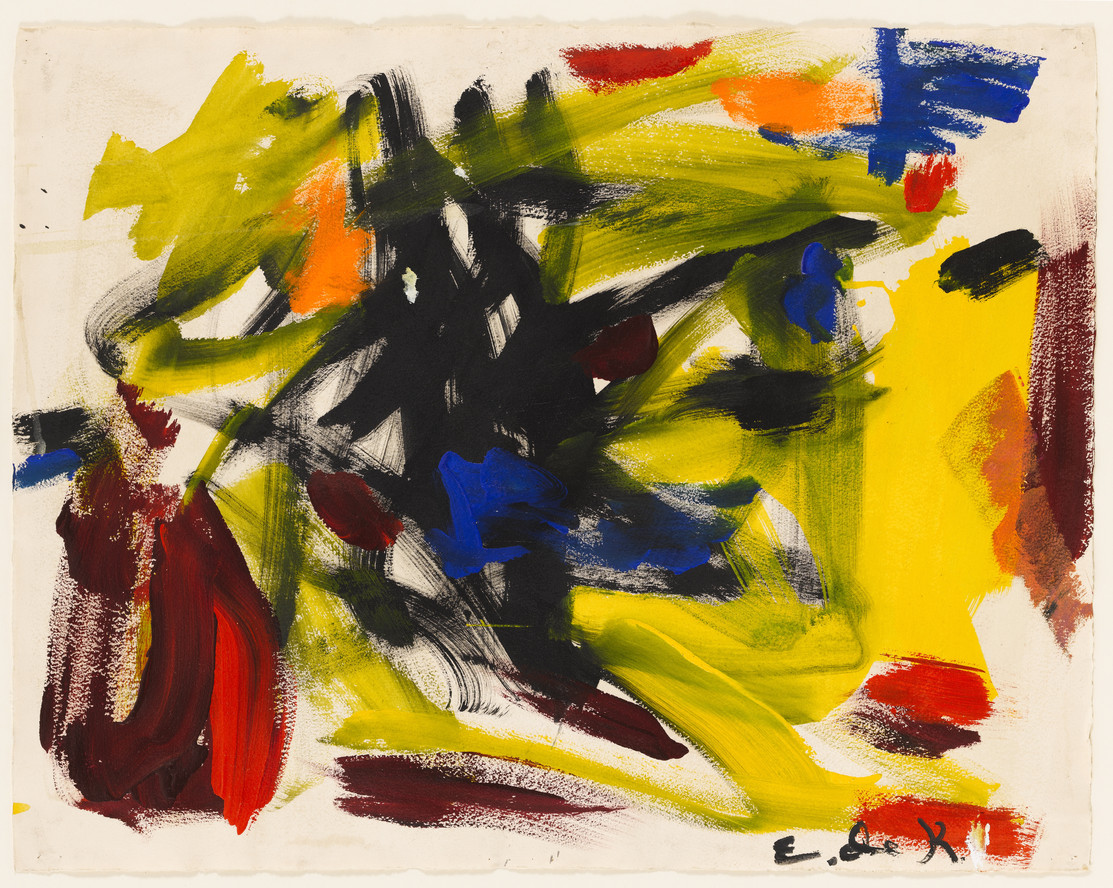
Elaine de Kooning. Bullfight. 1960
In the early 2000s, a peculiarly stiff version of IPA arose in Northern California. Brandishing precipitous, slicing bitterness and massive piney/citrus hop aromatics, these beers were dubbed "double IPAs." The most iconic—and still one of the best—is Pliny the Elder from Russian River Brewing Company of Santa Rosa (and now Windsor), CA. The beer is strong and explosively flavorful, but counterbalanced. It might seem shocking at first sip, but if you lot can shift yourself into Pliny'southward earth, information technology somehow becomes a perfect drink.
Our painting from MoMAs collection is Elaine de Kooning's Bullfight. The toreador is evinced past dashes of elegant red, posed as if to dance. The balderdash, rendered as a blurred set of black strokes, resembles a dynamic piece of Japanese calligraphy and seems to charge violently from every angle at once. A toreador tries to make this dance of death look easy. But information technology isn't piece of cake, and neither is brewing a great double IPA like Pliny. Russian River's brewmaster, Vinnie Cilurzo, one time told me that he likes the bitterness of Pliny to be a lilliputian bit threatening rather than tame.
PILSNER
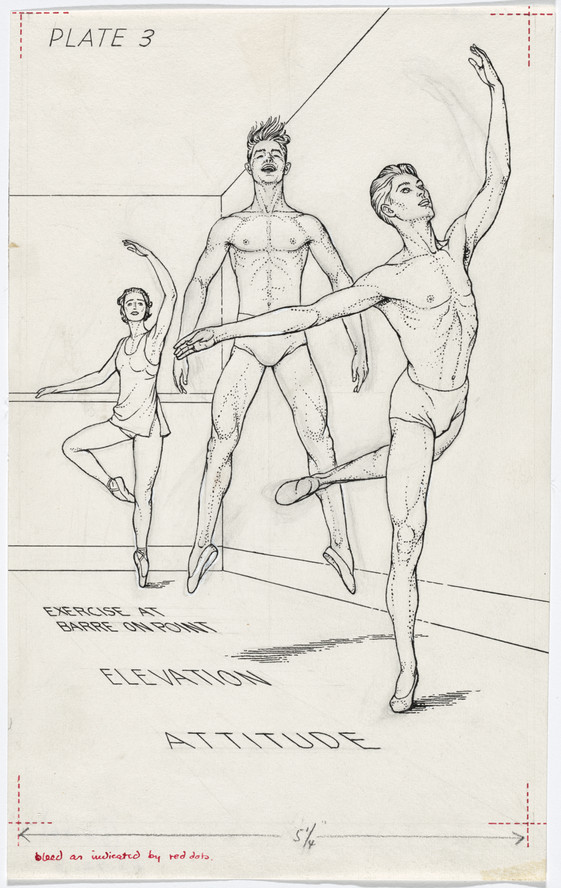
Paul Cadmus. Plate 3 from Ballet Positions. Cartoon for Ballet Alphabet: A Primer for Laymen. 1939
Born in Czech Bohemia in 1840, genuine pilsner is a very classical course—precipitous, articulate, gilded-colored, and floral. Though frequently bowdlerized around the world, in its Fundamental European home Pilsner rarely strays. Jever Pils comes from Lutheran Northern Germany and wears its angular and severely biting flavour contour like a bluecoat of laurels. That doesn't mean it isn't delicious.
Hither at MoMA, consider Paul Cadmus's Plate 3 from Ballet Positions. This drawing, fabricated in 1939, carries with it all the weight of its momentous year. Cadmus's photo speaks of classicism but also of a certain nascent severity of perfection. Some people feel this manner most pilsner, as well. In their expression of pilsner, many Germans once felt—and some still feel—that they had perfected beer.
LAMBIC
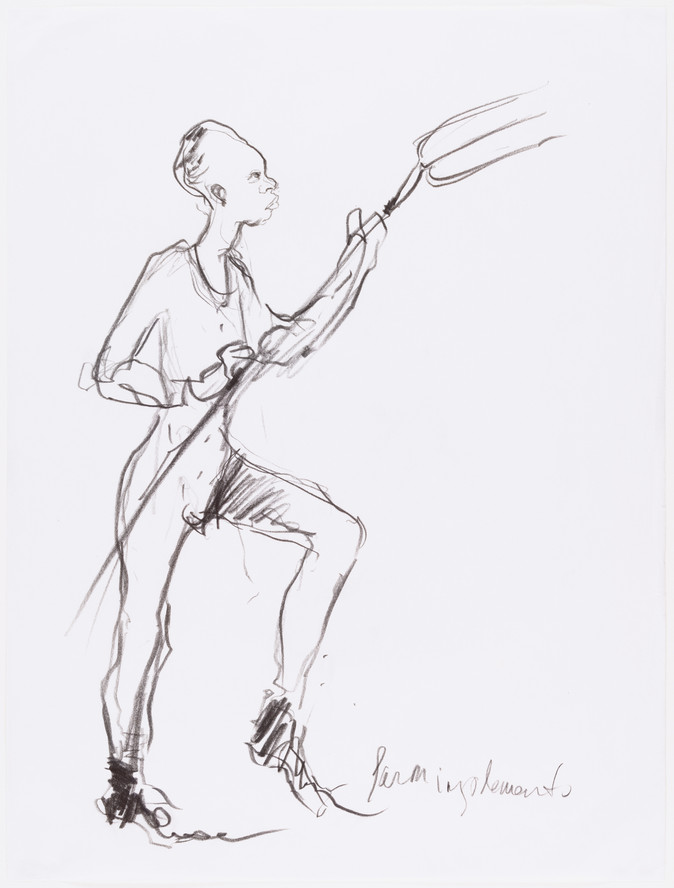
Kara Walker. Untitled. 1996
The lambics of Belgium comprise one of the oldest beer types on Earth. No drink achieves more terroir than lambic beer, as its flavors are literally the flavors of the countryside. Rather than subjecting the wort (the sugary grain-derived liquid that ferments into beer) to a sterilizing boil and a laboratory-derived yeast, the brewer relies on wild native fermentation, and the results can be complex and magnificent.
Of course, this type of fermentation isn't unique to Belgium. Similar beers remain key to many African societies today. So our beer hither is bil-bil, the traditional millet-based beer of the Northern Congo. We accept no brand name because it is not commercialized by European-based brewing groups; instead it's an ancient home economy, largely carried out by women.
Our artwork here is an untitled drawing by Kara Walker (1996). The pitchfork suggests a peasant or farmer, the sort of person who in Belgium might brew a lambic. The script below appears to say "farm implements." Just this man, who has African features, does not look equally if he intends to sow millet for beer. He looks adamant and tumescent with anger. He may be a farmer, and he and his family may brew beer, but today he looks to be brewing a vengeful war. Perhaps you lot are a beer fan but have never heard of bil-bil or umquombothi? That's not a surprise. Ancient beers were invented in Africa and belong to all the peoples of the Earth, not just to Europe. Maybe this man intends to take them dorsum.
BARLEY WINE
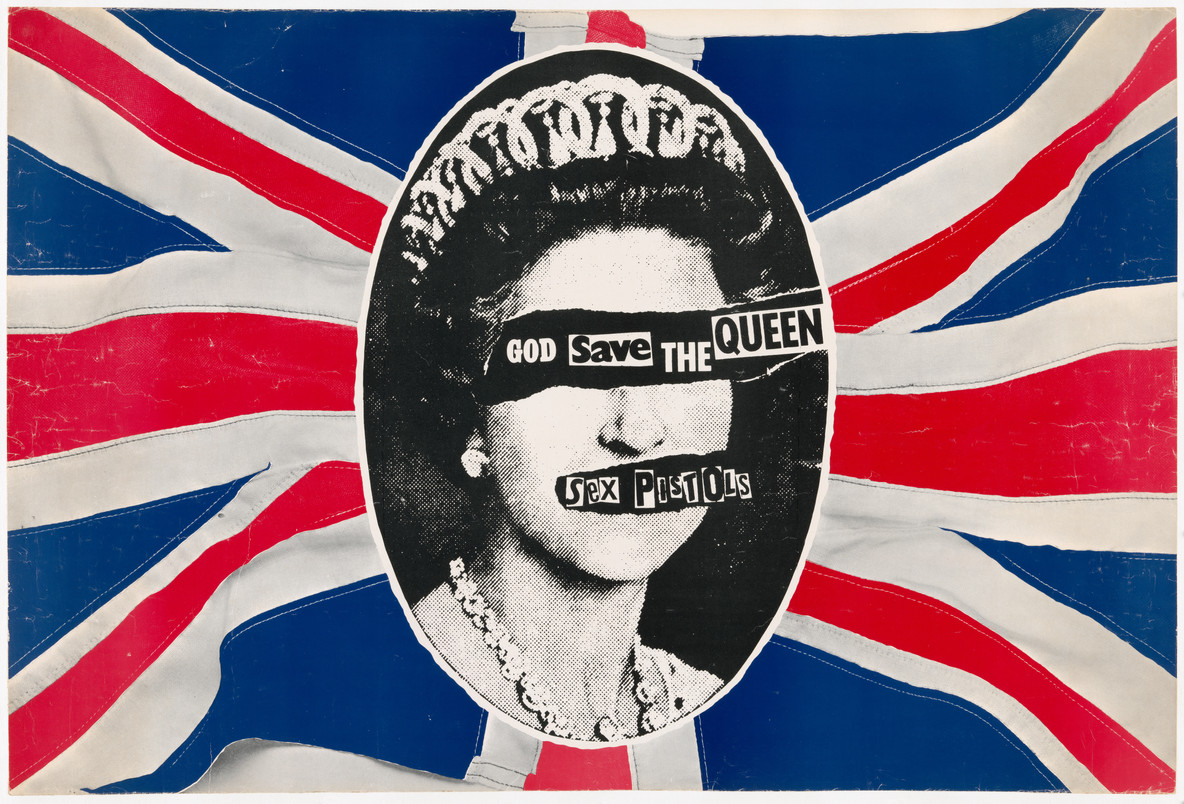
Jamie Reid. Sexual activity Pistols, God Salvage the Queen. 1977
One of my favorite beer styles, "barley wine" is very strong, often between 12 and 14% booze. Having first appeared in England in the 1700s, barley wines were brewed by and for the aloof houses of England. Then they were laid down in oak barrels, sometimes for decades. I've had the privilege to drink more than 20 different barley wines that were more than 100 years old, some of them "coronation ales" brewed to commemorate an ascent to the British throne.
Bang-up British barley wines, like J.West. Lees Harvest Ale, can age well for decades, simply exist largely to be exported to appreciative beer fans elsewhere in the world. Peradventure there is a parallel there to the British monarchy, so beloved past Americans, but viewed with an ochre centre by many subjects at home. Our lithograph is Jamie Reid's iconic artwork for the Sex Pistols' second unmarried, "God Relieve the Queen." In 1977 this artwork was shocking; not anymore. Every bit Britain braces for an imagined and nostalgic "sovereignty," nosotros are left to wonder whether Brexit, if it happens, shall truly glitter.
Garrett Oliver is the brewmaster for the Brooklyn Brewery in New York City. He is the writer of The Brewmaster's Table, the editor-in-chief of The Oxford Companion To Beer, and the winner of the 2014 James Beard Foundation Honor every bit "Outstanding Beer, Vino, or Spirits Professional." He lives in Brooklyn.
DOWNLOAD HERE
How to Draw a Pint of Beer TUTORIAL
Posted by: shannonsamay1943.blogspot.com


Comments
Post a Comment